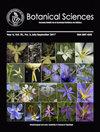Usos tradicionales y prácticas de manejo de Piper auritum en comunidades maya rurales de Yucatán
IF 0.7
4区 生物学
Q3 PLANT SCIENCES
引用次数: 0
Abstract
Background: Plant domestication is a continuous, multidirectional process that is directed via plant selection and management. In the current study we use Piper auritum, an aromatic plant frequently used in Mexican cuisine and for medicinal purpose, to characterize the domestication level using information about its cultural relevance, management practices and leaf traits differentiation in managed and ruderal populations. Questions: What is the level of domestication of the aromatic plant Piper auritum? Are there any morphological or phytochemical differences between home garden and ruderal populations? Studied species: Piper auritum, Kunth Study site and dates: Ten communities in eastern Yucatan, México, from 2019 to 2021. Methods: Fifty-three Semi-structured interviews were applied (72 % women and 28 % men). Morphological and phytochemical leaf traits were measured to test management effects using home garden and ruderal populations. Results: People interviewed knew P. auritum and its uses. Five culinary and 12 medicinal uses were registered. P. auritum is grown in homegardens and the main management activity is irrigation. The selection occurs at the leaf level according to their size and resistance. Home garden plants registered greater foliar area and hardness and decreased safrole, compared to ruderal. Conclusions: Piper auritum is widely known in the communities and has a variety of culinary and medicinal uses. Management is vital for its survival in home gardens, but the species germinates spontaneously and is not usually planted. We found differences in leaf traits in managed and unmanaged populations. With this evidence we propose that P. auritumis under incipient domestication.尤卡坦玛雅农村社区的传统使用和管理做法
背景:植物驯化是一个连续的、多方向的过程,通过植物选择和管理来指导。在目前的研究中,我们使用了一种经常用于墨西哥烹饪和药用的芳香植物——金胡椒,通过其文化相关性、管理实践以及管理种群和粗鲁种群中叶片性状分化的信息来表征驯化水平。问题:芳香植物金胡椒的驯化水平是多少?家庭花园和野外种群之间有任何形态或植物化学差异吗?研究物种:金风笛,Kunth研究地点和日期:2019年至2021年,墨西哥尤卡坦半岛东部的十个群落。方法:采用五十三次半结构化访谈(72%为女性,28%为男性)。利用家庭花园和野外种群对叶片的形态和植物化学特性进行了测量,以测试管理效果。结果:受访人员了解金合欢及其用途。登记了5种烹饪用途和12种药用用途。金合欢生长在家庭花园中,主要的管理活动是灌溉。根据它们的大小和抗性,在叶片水平上进行选择。与鲁德拉尔相比,家庭花园植物的叶面面积和硬度更大,黄樟素含量降低。结论:胡椒在社区中广为人知,具有多种烹饪和药用用途。管理对其在家庭花园中的生存至关重要,但该物种会自发发芽,通常不会种植。我们发现管理种群和非管理种群的叶片性状存在差异。有了这些证据,我们认为金黄色葡萄球菌处于早期驯化状态。
本文章由计算机程序翻译,如有差异,请以英文原文为准。
求助全文
约1分钟内获得全文
求助全文
来源期刊

Botanical Sciences
Agricultural and Biological Sciences-Plant Science
CiteScore
1.90
自引率
21.40%
发文量
71
审稿时长
16 weeks
期刊介绍:
Botanical Sciences welcomes contributions that present original, previously unpublished results in Botany, including disciplines such as ecology and evolution, structure and function, systematics and taxonomy, in addition to other areas related to the study of plants. Research reviews are also accepted if they summarize recent advances in a subject, discipline, area, or developmental trend of botany; these should include an analytical, critical, and interpretative approach to a specific topic. Acceptance for reviews will be evaluated first by the Review Editor. Opinion Notes and Book Reviews are also published as long as a relevant contribution in the study of Botany is explained and supported.
 求助内容:
求助内容: 应助结果提醒方式:
应助结果提醒方式:


